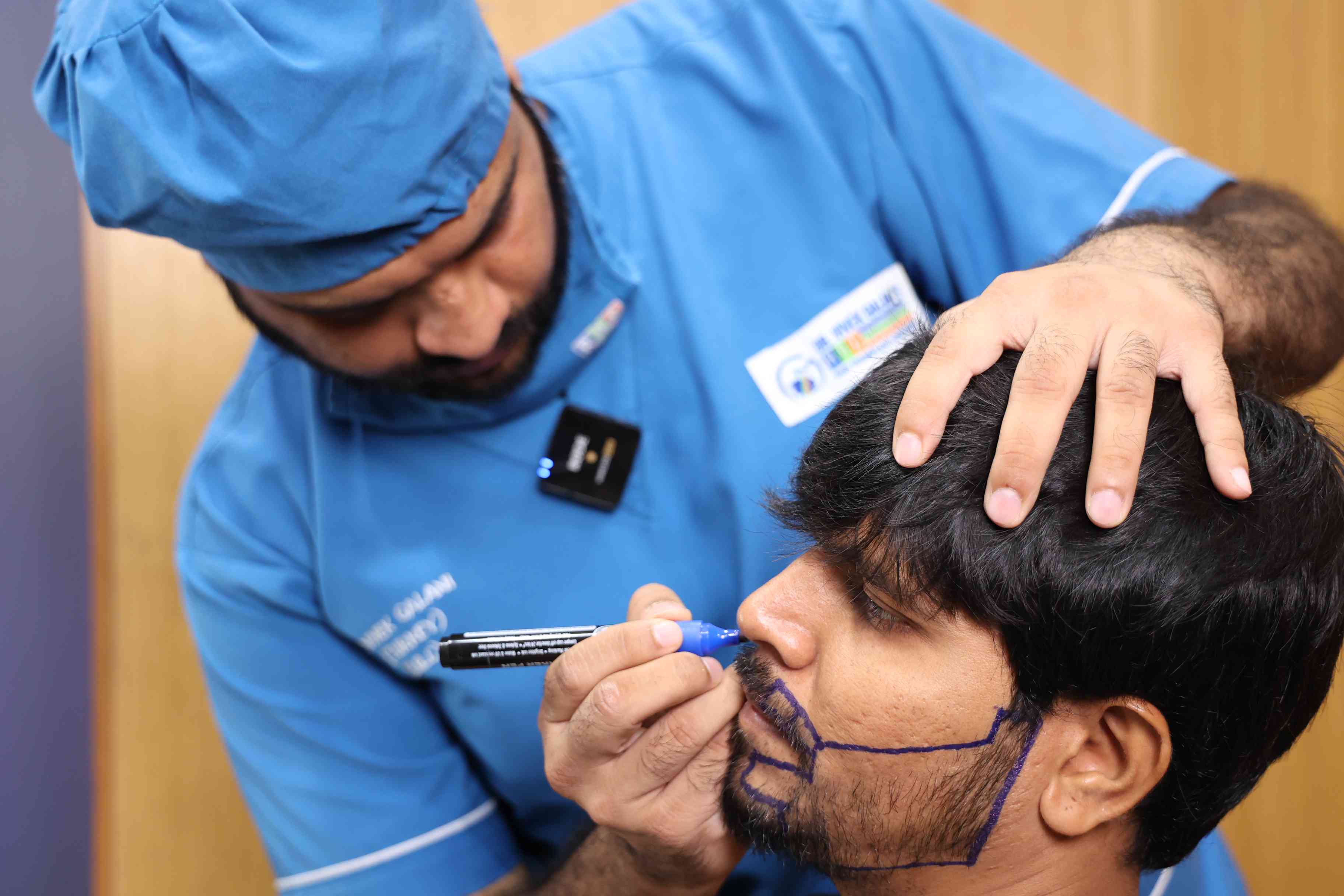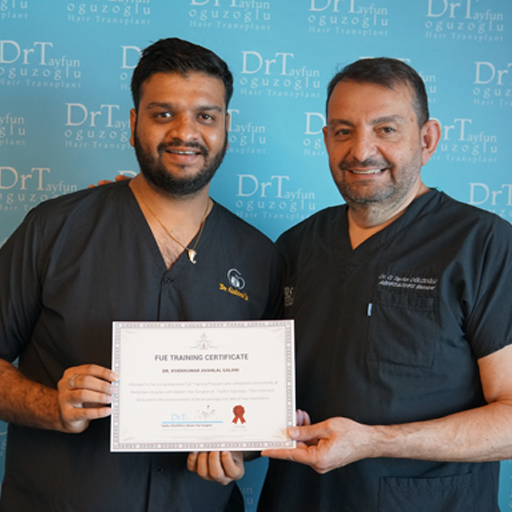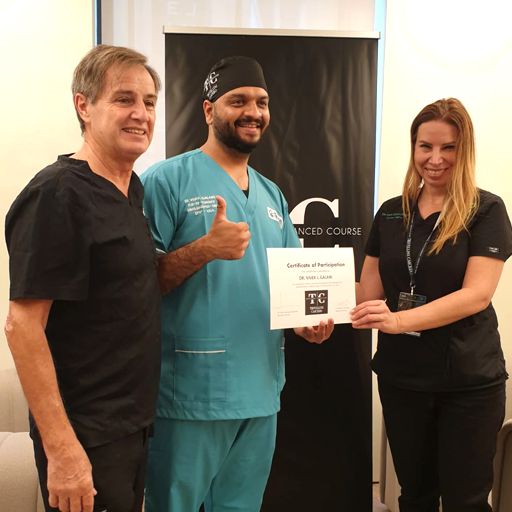

Want expert help without waiting? Book a priority consultation today.
A beard hair transplant is a minimally invasive procedure that involves transplanting hair follicles from one part of your body, typically the scalp, to areas of your face where you want to enhance the density of your patchy beard or grow a full beard where you never had a beard since birth.
Whether you’re looking to fill in patchy areas, define your beard shape, or achieve a fuller beard, our skilled team at RQC Hair Transplant Clinic offers personalized solutions tailored to your unique needs.

After many beard hair transplants at RQC in different age groups we have witnessed changes in looks, self-esteem, and confidence boosting through the roof.
Step 1 - Initial Consultation and Evaluation
The purpose of this consultation is to assess your current situation, understand your expectations, and guide you toward the best possible results. We are here to help you make the best decision for your hair health, with two great options to get started:
1️⃣ Exclusive 1-to-1 Video Consultation with Dr. Vivek Galani (Chief Hair Transplant Surgeon at RQC)
📅 Get personalized advice directly from Dr. Vivek Galani.
💡 Discuss your concerns and receive a tailored treatment plan.
💰 Consultation Fee: 799/- INR
Payment Link: https://rzp.io/l/yMtrMdyG
Dr. Vivek Galani will conduct a thorough consultation to assess your beard goals, facial structure, and donor hair quality.
2️⃣ Free Hair Assessment
📝 Fill out a quick form, and our experts will provide a customized assessment for you.
🚀 Click here to start your free assessment: https://forms.gle/rnmNmd2cTwEqeePi8
Step 2: Beard Hair Transplant
1. Beard Hair Line Design: To get natural-looking beard transplant results, the position and shape of the hairline play a crucial role. On the day of the beard hair transplant, before starting the procedure, our doctors understand your needs and design the hairline that matches your age and facial features. We make sure our clients are 100% satisfied with the design before we start the beard transplant procedure.
2. Local Anesthesia: To make the Beard Hair Transplant Procedure painless or minimally painful, local anesthesia is used. One session of beard hair transplant usually takes 7-8 hours on average, and to make the entire procedure comfortable, local anesthesia is given in the donor and recipient area usually taking 5-7 minutes. Before giving local anesthesia to any patient test dose is given into the forearm as a precaution to avoid any allergic reaction.
3. Extraction: Extraction during a beard hair transplant is a two-step process:
Step 1: During the first step, an experienced hair transplant surgeon uses high-quality instruments to carefully separate each hair from your skin in the safe donor zone (back of the head) to minimize the failure rate (Transection rate) of hair transplant.
Step 2: During step 2 of the extraction process in hair transplant experienced team members pull out the hair graft from the donor which was separated by the hair transplant surgeon doctor in step 1 and store this graft in an ideal environment for the implantation process.
4. Graft Storage and Preparation: During this step, graft is stored in a sterile environment using the latest technologies to maintain the temperature and sterility of the graft. The graft is also prepared by cleaning it and removing unwanted tissue by an experienced team member during the beard hair transplant procedure.
5. Slitting: This process is done in the recipient area (where you want to grow your beard hair back) during the beard hair transplant. The hair transplant surgeon creates tiny channels where your grafts will be implanted in the next step. To perform this step, we use a specialized technology—Sapphire FUE, a revolutionary technology for beard hair transplant in India that was brought by Dr. Vivek Galani from Turkey in 2020 and awarded by Dr. Tayfun Oguzhoglu.

6. Implantation: This is the final step of the beard hair transplant, where experienced team members implant the stored hair grafts back into the channels created by the hair transplant surgeon.
Dr. Vivek Galani was also awarded by Dr. Laura Caicedo (Spain) for performing an advanced beard hair transplant in India in 2022.

Step 3 - Post-Procedure Care
Aftercare instructions play a very important role to ensure smooth recovery and the best possible results.
1. Antibiotics and Painkillers: These medicines help you for fast recovery and minimize the pain and risk of infection.
2. Spray: To keep the implanted graft hydrated, the hair transplant surgeon will advise you to spray the implanted area.
3. Forehead Massage: This exercise minimizes the risk of swelling after a beard hair transplant.
Avoid direct sunlight and direct damage to the implanted graft.
You may notice difficulty opening your mouth completely or chewing food, but you will be able to drink juices or other liquids. Remember, this discomfort is nothing compared to the situations we face due to a lack of beard.
By understanding these factors and selecting a skilled hair restoration specialist, the risk of developing cobble-stoning or hair bumps can be significantly minimized, ensuring smoother and more natural results after a beard hair transplant.
Eligibility Criteria:
Expertise in Facial Hair Restoration:
I am Parvez ilyasbhai Mansuri . From Zankhav Gujarat. I am a car mechanic I am suffered hairfall problem last two years and also i take medicine for it but I don't get sufficient result. Onday while using instagram I found the name" RQC The hair tr...
Read More
Hi there, my name is parimal modi and i am from australia. i have hairfall problem and i got reference of Dr. vivek galani and then i took consultation. he is so kind. he answered all of my questions in very good manner. i had my sugery 7 days ago an...
Read More
Its been 9 months approx my hair transplant surgery and I completely satisfied and happy with my result . Team at rqc is brilliant and they took proper care between these months by proper reminders and msg. And solve all my queries whenever I needed...
Read More
hi there, my name is vikas and i am from surat. it's been 1.5 years of my hair transplant surgery and i am so happy with my results. you can clearly see my well growing hairs. . I had to update this year I had completed more than 2 yrs of my surger...
Read More
I can't express enough gratitude to RQC hair transplant centre for the incredible hair transplant they performed. The entire team at the clinic was incredibly friendly and made me feel at ease throughout the entire process. The clinic itself was well...
Read More
Everything is set brother. There is no point in tension It is a very big clinic, many people have doubts as to how it will be done but visit it. It will make a difference😇
Read More
Hello my name is Narendra sengar and I am from chandrapur Maharashtra. I had my surgery 2 years ago and I had a great result. I am very satisfied with the rqc team work . They always guide whenever you have a queries and always answer my call and MSG...
Read More
Deepak Jain here, from khandwa (MP). My hair transplant was done two days ago, and Dr. Vivek Galani had set everything up in a very nice way. Everything happened in the same way, there was a ghost in the beginning but it did not work after the proced...
Read More
Hello, My Name Is Jaydip From Surat, kayargam And I Come in for hair transplant in this hospital. My review for this :- There behaviour are good and here all are very supportive and give best facilities thanks to all doctors and nurses for this. Spe...
Read More
Hi there, my name is parimal modi and i am from australia. i have hairfall problem and i got reference of Dr. vivek galani and then i took consultation. he is so kind. he answered all of my questions in very good manner. i had my sugery 7 days ago an...
Read More
It was good experience at dr.vivek galani’s clinic. I came to know about dr.galani’s from google . Consultation experience was good as he explains in detail about hair transplantation process so you get the idea about everything.Staff’s behaviour was...
Read More
I recently had a hair transplant in RQC and I would say that I was really impressed with Dr Vivek and the Staff. It is a must visit place if you have any type of hair problem. The staff is very good and is always ready for your help. Dr Vivek a very...
Read More
My name is kamlesh nikum and I am from vapi. Approx one year ago I did my beard transplant surgery from Dr. Vivek galani's RQC hair transplant clinic and I'm beyond excited to share my experience with the hair transplant clinic! They were absolutely...
Read More
I am Parvez ilyasbhai Mansuri . From Zankhav Gujarat. I am a car mechanic I am suffered hairfall problem last two years and also i take medicine for it but I don't get sufficient result. Onday while using instagram I found the name" RQC The hair tr...
Read More
My name is Hitesh Patel and I am from bharuch .it's been 1 week of my surgery and I had visited today for hairwash and my surgery day was very good. I was scared before but during surgery they make me feel comfortable and explained every process to...
Read More
My name Saurabh sumbe and I had my hair transplant surgery at rqc clinic on 11 sept . Starting from hair line planning I was very excited to experience what is for the day and how it will be and whenever you think of surgery it makes you scared but...
Read More
Yes, beard hair transplants are highly effective. During a beard hair transplant in India, hair follicles are taken from a donor area (usually the scalp) and implanted into the beard region where you desire more facial hair. The transplanted hair will grow naturally and permanently in the new area, allowing you to achieve a fuller, denser, and well-shaped beard.
A beard hair transplant is a permanent solution. Once the transplanted hair follicles have successfully integrated into the beard area, they will continue to grow like natural facial hair for a lifetime. It typically takes about 16-18 months to see the full beard transplant results, and these results will last as long as the natural hair follicles remain healthy.
A beard hair transplant is generally not painful, as the procedure is performed under local anesthesia. You might feel mild discomfort or a slight pinching sensation during the anesthesia injection, but the actual transplant is pain-free. After the procedure, some patients may experience minor swelling, redness, or tenderness in the treated area, but these effects are temporary and can be managed with prescribed pain relievers and proper aftercare.
The number of grafts required for a full beard hair transplant varies based on individual goals, the current density of facial hair, and the desired thickness and coverage. On average, a full beard hair transplant cost in India may involve 3,000 to 4,000 grafts, but this number can range from 500 to 4,000 grafts, depending on specific needs. A personalized consultation with your surgeon will provide a more accurate estimate.
The beard hair transplant price in India can vary widely depending on the number of grafts needed, the complexity of the procedure, and the surgeon’s experience. We offer an EMI facility for clients who need financial assistance with the beard transplant cost.
Common side effects of a beard hair transplant include mild redness, swelling, or itching in the treated area, which typically resolves within a few days. Less commonly, there may be minor scabbing, temporary numbness, or small bumps (folliculitis) around the transplanted follicles. Rare side effects, such as infection or scarring, are minimized with proper technique and aftercare.
Beard hair transplants in India generally have a high success rate, with most patients achieving satisfactory results. The success rate can vary depending on the skill of the surgeon, the quality of the donor hair, and adherence to post-procedure care. On average, success rates are around 90-95%, with many patients enjoying a natural-looking and long-lasting beard.
The procedure typically takes 5 to 8 hours, depending on the number of grafts required and the complexity of the beard design.
Yes, we use your own hair, meticulously placed at the correct angle and direction, ensuring a natural look that blends seamlessly with your existing facial hair.
